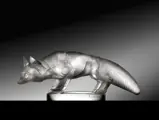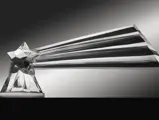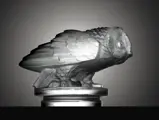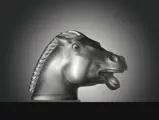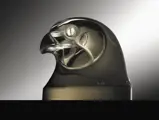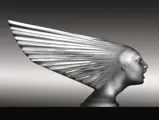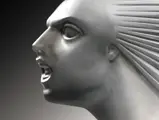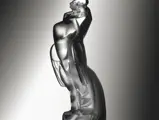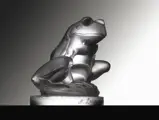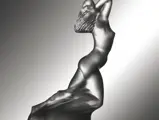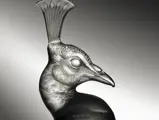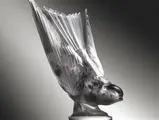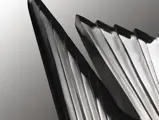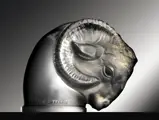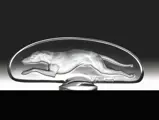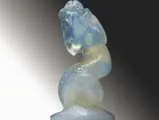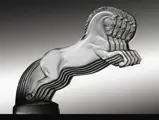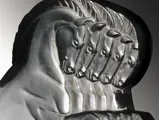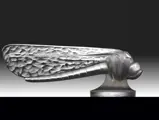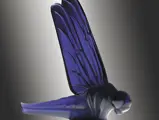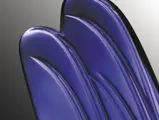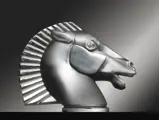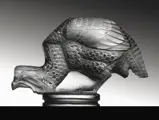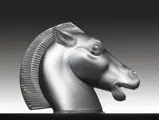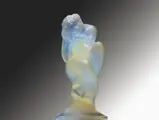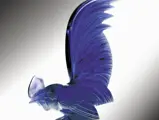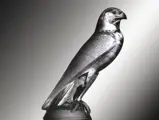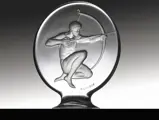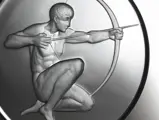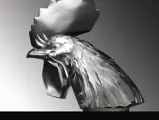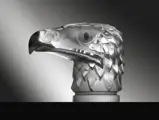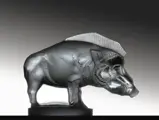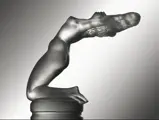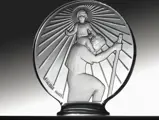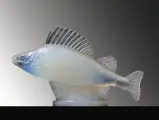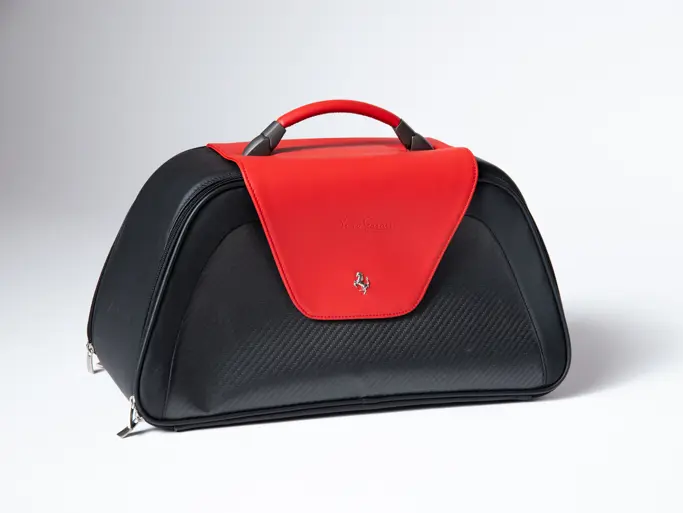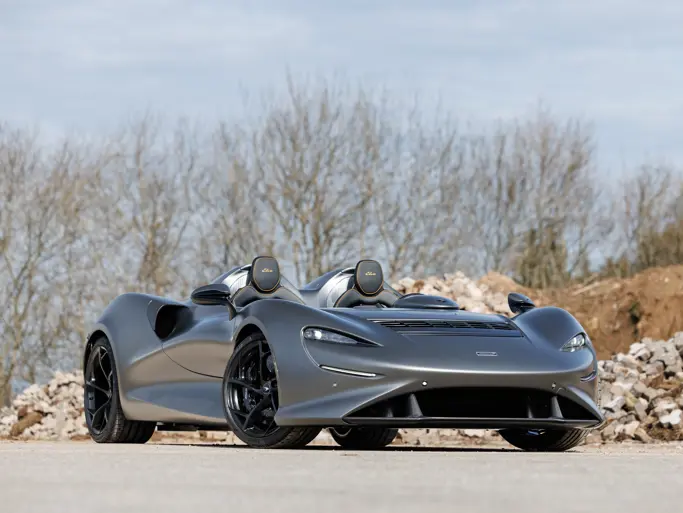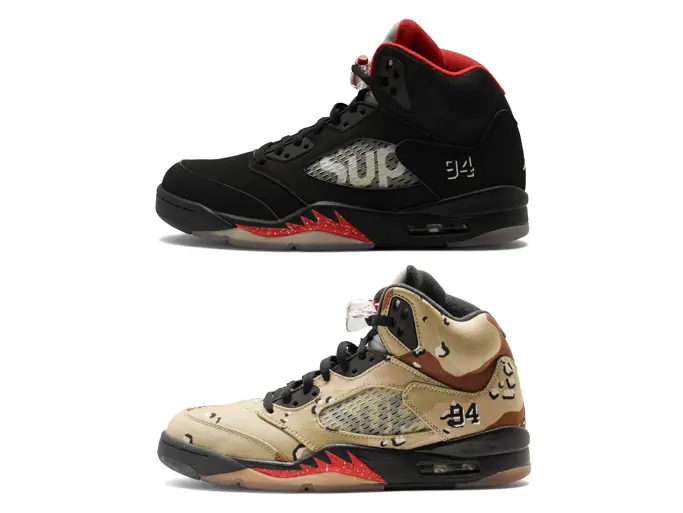A complete 30-piece collection with valuable, custom display cases
Amelia Island 2012
The Lalique Mascot Collection of Ele Chesney
{{lr.item.text}}
$805,000 USD | Sold
 | Amelia Island, Florida
| Amelia Island, Florida
{{internetCurrentBid}}
{{internetTimeLeft}}

Whether a signature on a sculpted automobile mascot, vase, perfume bottle, chandelier, unique item of jewelry, crystal clock or any piece in a broad spectrum of other decorative or utilitarian items, Lalique conjures a mental image of exquisiteness, sophistication and excellence. Viewing the rare works of René Lalique leaves one in awe of his masterful ability.
René Lalique was born on April 6, 1860 in Ay, France. By the age of 12, he was winning awards for his drawings. His mother guided her teenage son into the world of art when she arranged for Lalique to serve an apprenticeship with the famous Parisian jeweler and goldsmith, Louis Aucoc. During this period, Lalique began studies at the École des Arts Decoratifs, continued coursework in England and finished his formal education at the École Bernard Palissy in 1880. The 21-year-old was already creating original, eye-catching pieces of jewelry. In 1885 he opened a workshop, and his unique style of jewelry gained widespread renown with the incorporation of flowing majestic plant, animal and human forms in his works. He further enhanced his designs with the use of horn, ivory, pearl, coral, enamel, plastic or glass in-laid with semi-precious stones. Lalique’s creations drew the attention of prominent personalities such as Sarah Bernhardt, the leading actress of her day. For Lalique to have her as a major client was to draw a wellspring of other affluent and influential personages to his creations. By 1900, at the Paris Exposition Universelle, his innovative exhibit attracted vast crowds, and demand for his work placed him at the pinnacle of success in the field of jewelry.
Rejecting complacency, Lalique embraced new challenges. He had already experimented with glass in jewelry making and, by age 50, conceived a new goal of becoming a master glassmaker. The achievement of this goal would gain him worldwide fame that continues today. Lalique opened a small glass shop near the famous perfumer Francois Coty, for whom he began creating classic perfume bottles. Soon, he was engaged by D’Orsay, Forvil, Rogeret et Gallet and many others. In all, Lalique created more than 250 different bottles, some with collector values that currently exceed $100,000.
Like so many other artists from the 1880s through the 1920s, Lalique recognized the need to bring art into everyday life. The only way to accomplish this was to begin mass production of stemware, tableware, inkwells, clocks and vases. At the height of production, Lalique employed 600 people in his glass factories. These skillful artisans created millions of pieces of glassware, many “personalized” with highlight polishing, frosting and glazing for a trademark presentation of individualized attention.
A contemporary invention of his day, the automobile, began to enamor the creative mind of Lalique. Prior to WWI, the artist created bas-relief silver and bronze ‘Targa’ gift plates for winners of the famous Targa Florio races in 1906. Vincenzo Florio commissioned Lalique to design a trophy for the prestigious event. Lalique created a work that anyone would be proud to win; he captured the image of the driver and mechanic speeding down a country road bordered by flowers and birds in flight with the “sky suggested in blue enamel.” By 1920, Lalique envisioned a new goal for the automobile: an empirical decoration on the front hood, elevating glass artistic design above the metallic standard in the mascot. Once a thermometer sat on the radiator simply to measure water temperature; Lalique now proposed elegant, artistic presentation over such mere functionality.
In 1925, André Citroën’s company was a primary sponsor and exhibitor for the Exposition Internationale des Arts Decoratifs et Industriels Modernes in Paris. The motoring magnate rented the Eiffel Tower and had thousands of lights artfully attached to the structure. At night, the double chevron emblem and name “Citroen” was an extraordinary sight seen by millions of people in “The City of Lights.” Knowing he would be displaying his company’s Citroën 5CV, Citroën commissioned Lalique to create a glass mascot that could be mounted on the radiator of the car. Citroen wanted the mascot to feature five prancing horses. Thus was born Lalique’s fifth mascot, “Cinq Chevaux.”
The success of the Citroën mascot exposed his unique talent to an entirely new audience. During the next seven years, Lalique created a total of 27 mascots, symbolizing energy, speed and motion; religion; individuality and form of nature; and human sensuality and sexuality—each expressing the grace and details of human and animal forms.
The other mascots needed to complete this photographic collection include Sirène (small mermaid) and Naïade (large mermaid). Both were originally offered as paperweights in 1920 and had base sizes equaling those of other mascots. Longchamps (#1152B: horse head – single mane, a variation of longchamps #1152A: horse head – double mane) crowns the collection totaling 30 pieces. These comprise the 1932 Lalique catalogue.
The mascots were created in high-quality glass with a clear, frosted or satin finish. Some were tinted in amethyst and pink, while others were highlighted minimally with subtle colors. Lalique marked his work, as a general practice, with “R. Lalique” followed by the word “France.” The signature clearly marks the base through molding, etching, script, print sandblasting or a curved design. Occasionally, the leading ‘L’ in the earliest cursive “Lalique” signature has a flourish at the top, which makes the letter resemble an ‘S.’
Lalique immediately saw the opportunity to draw attention to his mascots by lighting the glass sculpture from underneath its base. A small bulb was connected to provide the illumination. Lalique fashioned filters for placement between the bulb and base of the glass sculpture; this allowed color changes to red, blue, green, amber or mauve. The idea was novel and stylish.
Due to demand, the artist contracted with the Breves Gallery of London, England to assist with the design and development of the mascot mounting process, as well as with sales in Great Britain and overseas. Breves devised mounts in small and large sizes. In a 1929 advertisement, Breves called Lalique “the greatest living artist in glass design” and offered the mascots either “lighted or unlighted” which “easily fitted on the scuttle or radiator cap.” Breves designers knew that mounting an expensive glass mascot onto the hood was a difficult task. To avoid damaging the glass base, a rubber washer was formed to allow the mascot to sit snugly on the base. The mascot could be tightened yet remain unharmed. Once the automobile was in motion, however, a tightly-fitted mascot was subject to damage or chipping by bumps, road debris, weather conditions, rocks and wind pressure. For the loosely-fitted mascot, wind pressure from high speed, an accident or screeching halt usually sent the mascot flying into space. Also, the heat generated from the bulb inside the mascot and the engine weakened it structurally. Such conditions remain the primary reason that so few original Lalique mascots exist today. Even the finest mountings possible survived little more than a few years.
Soon, Lalique mascots adorned the hoods of Bentley, Bugatti, Hispano-Suiza, Isotta-Fraschini, Mercedes-Benz and other stylish automobile marques of the day. The mascots, like his other objets des arts, became globally recognized by the eve of WWII.
While actual production numbers of original Lalique mascots are unknown, Lalique mascot aficionados consistently agree on the importance of the pieces in general terms. The largest and most famous mascot is Victoire (spirit of the wind), which epitomizes the styling of the art deco period and premiered in 1928 on the hood of a Minerva automobile at the Paris Motor Salon. The mascot with the best design elements for dusk and nighttime illumination is the Grande Libelulle (large dragonfly). Its detailed, veined, extended wings expand the radiance of the light in both stationary and moving positions. The Faucon (falcon) is considered the heartiest mascot due to its tapered, thick base that allows for a tight fit into the mount. This factor, combined with its size and design, reduces the potential for damage.
Equally valued for exotic presentation of the female form are the two nude mascots, Vitesse (speed) and Chrysis (kneeling nude). Both works have been interpreted from a variety of artistic perspectives ranging from speed and motion of the car to mythological roots of love. Whatever the discussion, one must attempt to place himself in artistic thought of that period of European history, a time between two wars. Lalique clearly designed Vitesse as a nude leaning in a forward position and offering her beauty to her lover. In contrast, Chrysis reclines and welcomes her lover. The art has survived and grown in popularity over the past 60 years, and it is still produced by the Lalique glass company today.
Because of intricacy in the design and execution in production, mascots such as the Hibou (owl), the Pintade (guinea hen), the Epsom (straining head of horse), the Comète (comet), the Tête de Paon (peacock’s head) and the Tête de Bélier (ram’s head) were produced in lesser numbers. The Faucon (falcon), Tête Daigle (eagle’s head), Sanglier (boar) and the Coq Nain (bantam cock) were the most common. The easiest designs for fabrication were the three works called “roundaliers”: the Tireur d’Arc (archer), the Lévrier (greyhound) and Saint Christophe (St. Christopher). Lastly, the Renard (fox) is the rarest of all Lalique mascots. Only about seven are known to exist worldwide.
Lalique, the master artist, died in 1945. His son Marc reopened his factories, which had been closed during WWII. Lalique has become a “lifestyle brand,” offering jewelry, perfume, scarves and leather accessories in addition to crystal. Whether antique, vintage, art deco or modern, the enduring beauty of Lalique is its mystique. The grandeur and style of the man and his era will never be seen again.
ELE CHESNEY
René Lalique and Ele Chesney have a few things in common. Among them is their appreciation of beauty and the desire to share it with others.
Lalique created breathtaking innovations of beauty and substance during an era when royalty and privilege provided the primary access to fine works of art and sophisticated culture.
As a collector of the finest antique automobiles, Ele Chesney takes particular pleasure in sharing them with others. At car shows she considers herself privileged to witness the curiosity and delight in the faces of adults as well as children. At one show, a boy of 12 was drawn to her “Belmont,” and after mustering his courage, he asked for an autograph. Miss Chesney gave him an autographed picture of the car and the encouragement, “dream about it, work hard, and someday you too can own the car of your dreams.”
Miss Chesney remembers times as a child when things were not as prosperous. While her parents provided a healthy nurturing environment and a safe place to live, extras, such as going to the movies, treats and luxury items, were impossible without her entrepreneurial spirit. As a young lady Miss Chesney held odd jobs to acquire her first car, “Harry,” a 1941 Plymouth. Many years later Harry was restored and became a country fair and parade favorite, as well as a Grand National winner.
Today Miss Chesney is happily retired from several business ventures, most notably an electronics component manufacture for the defense and cellular communication industries. She remains known as the foremost woman collector of antique automobiles. Her love for cars extends to automotive fine art, making the Lalique mascots the centerpiece of her collection.
MASCOTS
Renard
Fox
Catalogue number: 1182
Signature identification: “R. Lalique France” stenciled on side of base
Date introduced: December 9, 1930
Dimensions: 21.5 cm long
Mount style: large, split collar
Production status: closed
Comète
Comet
Catalogue number: 1123
Signature identification: “R. Lalique France” stenciled along bottom edge of tail
Date introduced: August 24, 1925
Dimensions: 19 cm long
Mount style: small, full collar
Production status: closed
Hibou
Owl
Catalogue number: 1181
Signature identification: “R. Lalique France” acid-etched on vertical edge of upper lip of base
Date introduced: January 27, 1931
Dimensions: 12.5 cm long
Mount style: large, split collar
Production status: closed
Epsom
Straining Head of Horse
Catalogue number: 1153
Signature identification: “R. Lalique France” in molded relief on lower edge of neck
Date introduced: June 5, 1929
Dimensions: 18.2 cm long
Mount style: large, split collar
Production status: closed
Tête d’Épervier
Sparrow Hawk
Catalogue number: 1139
Signature identification: “R. Lalique France” molded in relief around lower edge of neck
Date introduced: January 21, 1928
Dimensions: 6.1 cm high
Mount style: large, full collar
Production status: closed
Victoire
Spirit of the Wind
Catalogue number: 1147
Signature identification: “R. Lalique France” molded in relief around the ease
Date introduced: April 18, 1928
Dimensions: 25.6 cm long
Mount style: large, split collar
Production status: closed
Coq Houdan
Strutting Cockerel
Catalogue number: 1161
Signature identification: “R. Lalique France” acid-etched on base
Date introduced: April 30, 1929
Dimensions: 22.5 cm high
Mount style: large, full collar
Production status: closed
Grenouille
Frog
Catalogue number: 1146
Signature identification: “R. Lalique France” acid-etched on underside of ease
Date introduced: May 3, 1928
Dimensions: 6.6 cm high
Mount style: small, full collar
Production status: closed
Vitesse
Speed
Catalogue number: 1160
Signature identification: “R. Lalique France” molded in relief around the lower edge of base
Date introduced: September 17, 1929
Dimensions: 18.5 cm high
Mount style: large, full collar
Production status: closed
Tête de Paon
Peacock’s Head
Catalogue number: 1140
Signature identification: “R. Lalique France” marked via intaglio on lower edge of neck
Date introduced: February 3, 1928
Dimensions: 17.7 cm high
Mount style: large, split collar
Production status: closed
Hirondelle
Swallow
Catalogue number: 1143
Signature identification: “R. Lalique France” in molded relief on base
Date introduced: February 10, 1928
Dimensions: 15 cm high
Mount style: small, split collar
Production status: closed
Tête de Bélier
Ram’s Head
Catalogue number: 1136
Signature identification: “R. Lalique France” molded in relief on lower neck
Date introduced: February 3, 1928
Dimensions: 9 cm high
Mount style: small, split collar
Production status: closed
Lévrier
Greyhound
Catalogue number: 1141
Signature identification: “R. Lalique France” marked via intaglio below thigh of left hind-leg
Date introduced: March 14, 1928
Dimensions: 20 cm long
Mount style: small, split collar
Production status: closed
Naïade
Large Mermaid
Catalogue number: 832
Signature identification: “R. Lalique” molded in relief just above tail fin
Date introduced: 1920
Dimensions: 13 cm high
Mount style: large, full collar
Production status: closed
Cinq Chevaux
Five Horses
Catalogue number: 1122
Signature identification: “R. Lalique” molded in relief between tail and rear legs
Date introduced: August 26, 1925
Dimensions: 15 cm high
Mount style: small, full collar
Production status: closed
Petite Libelulle
Small Dragonfly
Catalogue number: 1144
Signature identification: “R. Lalique France” molded in relief on lower end of back wing
Date introduced: April 12, 1928
Dimensions: 16.2 cm long
Mount style: small, full collar
Production status: closed
Grande Libelulle
Large Dragonfly
Catalogue number: 1145
Signature identification: “R. Lalique France” in molded relief around base or R. Lalique France acid-etched in script along tail
Date introduced: May 23, 1928
Dimensions: 21 cm high
Mount style: large, split collar
Production status: closed
Longchamps
Horse Head Single Mane
Catalogue number: 1152B
Signature identification: “R. Lalique France’ molded in relief on lower edge of neck
Date introduced: September 10, 1929
Dimensions: 13 cm high
Mount style: large, split collar
Production status: closed
Pintade
Guinea Hen
Catalogue number: 1164
Signature identification: “R. Lalique France” molded in relief around the lower edge of base
Date introduced: September 28, 1929
Dimensions: 11 cm long
Mount style: large, split collar
Production status: closed
Longchamps
Horse Head Double Mane
Catalogue number: 1152A
Signature identification: “R. Lalique France” molded in relief on lower edge of neck
Date introduced: June 12, 1929
Dimensions: 15.5 cm high
Mount style: large, split collar
Production status: closed
Sirène
Small Mermaid
Catalogue number: 831
Signature identification: “R. Lalique” molded in relief below tail
Date introduced: 1920
Dimensions: 10 cm high
Mount style: small, full collar
Production status: closed
Coq Nain
Bantam Cockerel
Catalogue number: 1135
Signature identification: “R. Lalique France” molded in relief around base
Date introduced: August 3, 1926
Dimensions: 205 cm high
Mount style: large, split collar
Production status: open
Faucon
Falcon
Catalogue Number: 1124
Signature identification: “R. Lalique France” molded in relief between tail feathers and back claws
Date introduced: August 5, 1925
Dimensions: 15 cm high
Mount style: large, full color
Production Status: closed
Tireur d’Arc
The Archer
Catalogue number: 1126
Signature identification: “R. Lalique France” marked via intaglio above the base, immediately beneath and between the left knee and right foot
Date introduced: August 3, 1926
Dimensions: 13 cm high
Mount style: small, split collar
Production status: closed
Tête de Coq
Cockerel
Catalogue number: 1137
Signature identification: “F. Lalique France” marked via intaglio at base on front of neck
Date introduced: February 3, 1928
Dimensions: 18 cm high
Mount style: large, split collar
Production status: open
Tête Daigle
Eagle’s Head
Catalogue number: 1138
Signature identification: “R. Lalique France” molded in relief around lower edge of neck
Date introduced: March 14, 1928
Dimensions: 10.7 cm high
Mount style: large, split collar
Production status: open
Sanglier
Boar
Catalogue number: 1157
Signature identification: “R. Lalique France” molded in relief on the side between the front and rear legs
Date introduced: October 3, 1929
Dimensions: 9.3 cm long
Mount style: small, split collar
Production status: open
Chrysis
Kneeling Nude
Catalogue number: 1183
Signature identification: “R. Lalique France” stenciled on underside of base
Date introduced: March 21, 1931
Dimensions: 14.5 cm high
Mount style: large, split collar
Production status: open
Saint Christophe
St. Christopher
Catalogue number: 1142
Signature identification: “R. Lalique France” marked via intaglio on lower left side behind St. Christopher
Date introduced: March 1, 1925
Dimensions: 13 cm high
Mount style: small, split collar
Production status: open
Perche
Perch
Catalogue number: 1158
Signature identification: “R. Lalique France” molded in relief on side between lower fins
Date introduced: April 20, 1929
Dimensions: 18 cm long
Mount style: small, split collar
Production status: open
DISPLAY CASES
This exceptional lot of Lalique mascots will be accompanied by two large display cases, custom made specifically for the collection. Each case features velvet-covered black boxes, optic lighting with special cooling system, staggered shelving, decorative posts and thick glass doors, all constructed at great expense and with tremendous attention to detail, to showcase the mascots as perfectly as possible with optimal lighting from within each piece. For further details please speak with an RM representative.
Approximate dimensions of each case:
height: 90"; depth: 22"; width: 33"

